Messier Monday: The Most Perfect Elliptical, M89
The Virgo Cluster of galaxies is the richest nearby treasure trove of ellipticals; this is the final one Messier ever found.
“We sail within a vast sphere, ever drifting in uncertainty, driven from end to end.” –Blaise Pascal
Back in 1758, Charles Messier was looking through a telescope for the return of Halley’s Comet. Initially he saw a faint, fuzzy object that he thought was the comet itself, only to realize that this was a fixed object in the night sky: the Crab Nebula, as it turned out. In order to protect other skywatching comet-hunters from making similar mistakes, he decided to catalogue all the bright deep-sky objects that could potentially be confused for comets. And his detailed and systematic observations of the night sky led to the first large, comprehensive catalogue of night-sky objects: the Messier Catalogue!
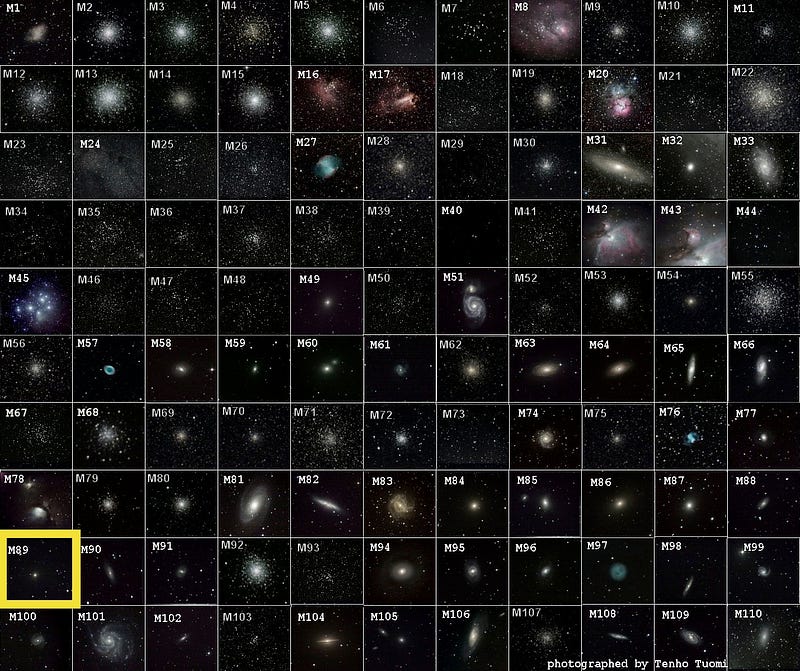
First published in 1771, Messier (along with his assistant, Pierre Méchain) continued to observe the night sky looking for new objects, winding up with a total of 110 in his catalogue. The date of March 18, 1781 was a particular coup for Messier, who himself found a record eight new galaxies (and one globular cluster) on that night, all in a similar region of sky now identified with the Virgo Cluster. Today’s object in particular, Messier 89, holds the dual distinction of being both the final giant elliptical ever found by Messier himself and also as the most perfectly spherical galaxy in the entire catalogue.
After sunset tonight, here’s how to find it.
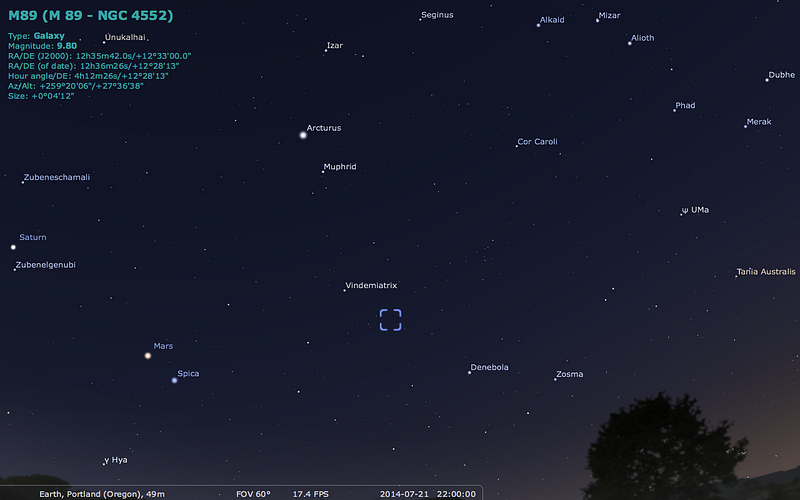
The most prominent northern hemisphere asterism — or collection of stars — is probably the Big Dipper, and following the “arc” of its handle will lead you to the brightest star in the northern celestial hemisphere: Arcturus. Instead of “speeding on to Spica” in the south, however, you could instead turn back towards the west a bit, and arrive at the two prominent stars Vindemiatrix and Denebola, which are by far the brightest two stars in their respective regions of sky.
It’s in between these two that Messier 89 — and a trove of Virgo Cluster riches — lies.
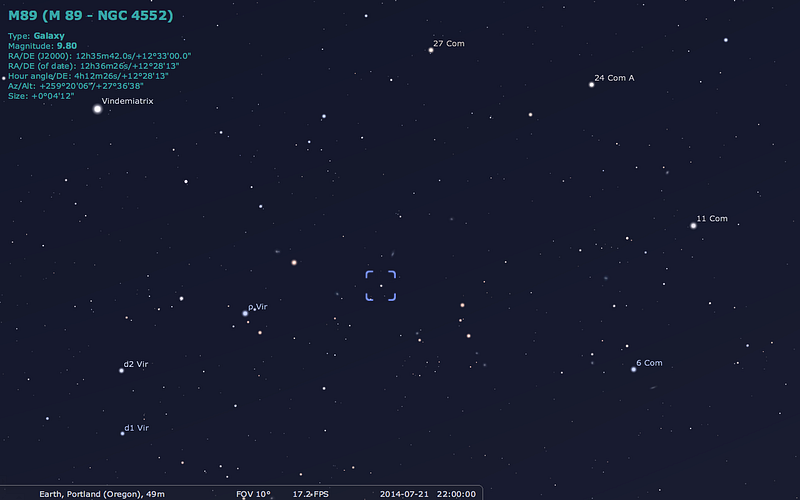
A number of faint (but still clearly visible) naked-eye stars lie in between Vindemiatrix and Denebola, with ρ Virginis lying closer to Vindemiatrix and just below the line connecting them, while 6 Comae Berenices lies closer to Denebola and just above that same imaginary line. If you start at ρ Virginis and navigate just another two degrees (roughly) to the west, you’ll find Messier 89 amidst a sea of other stars and deep-sky objects.
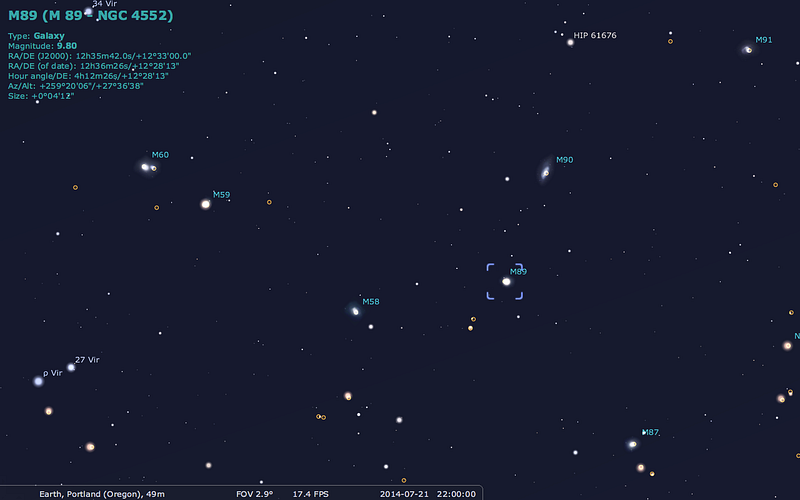
This galaxy may not be the brightest, most prominent or a very feature-rich galaxy, as Messier himself noted, stating it to be a:
Nebula without star, in Virgo, a little of distance from & on the same parallel as the nebula reported above, No. 87. Its light was extremely faint & pale, & and it is not without difficulty that one can distinguish it.
Through a modest amateur telescope, you’re likely to find something like this.

It’s intrinsically on the faint side, so you’ll need a dark, moonless night (like the first half of tonight ought to provide). Like many giant ellipticals, it has a bright (but not point-like) nucleus, surrounded by a much fainter halo of whitish, fuzzy featureless brightness that dims out and fades even farther as you move away from the center. What you’re looking at, unbeknownst to Messier, is a huge galaxy even larger than our Milky Way, more than 50% larger than our galaxy in diameter and more than double the mass.
But while most elliptical galaxies are, well, ellipsoidal, with one long axis and one short axis, Messier 89 appears to be nearly perfectly spherical!
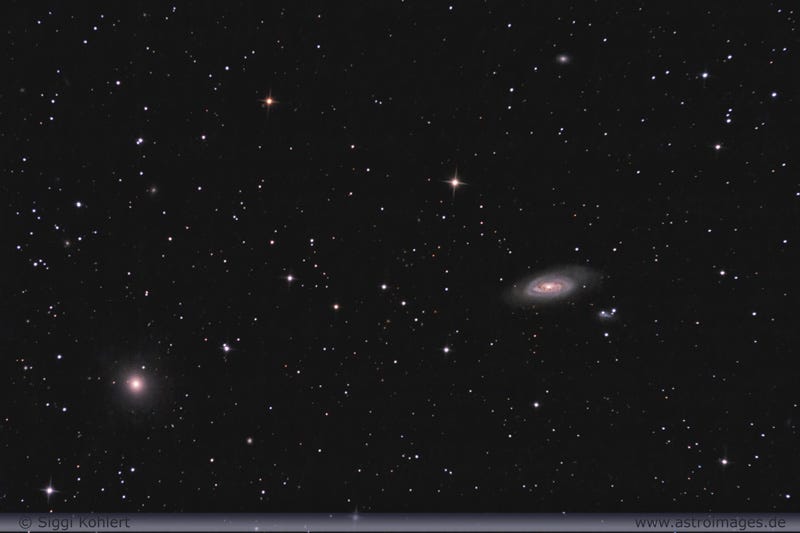
No one knows whether this galaxy is truly spherical in nature, or whether its long axis is simply oriented along our line-of-sight, hiding its true form from our eyes. Unfortunately, it will take nearly a hundred million years for this galaxy to rotate a sufficient amount for us to tell! Like most ellipticals, this one was thought to have formed from major mergers of smaller galaxies in the past, including (possibly) previous large spirals not so different from our own.
What we find in this galaxy today is mostly typical of giant ellipticals:
- A huge, supermassive black hole on the order of a billion solar masses, hundreds of times the mass of our own galaxy’s black hole.
- Thousands of globular clusters in the extended halo of this galaxy, extending for some 300,000 light-years in all directions from its center. This is about 15 times as many globulars as are found in our own galaxy.
- And finally, it seems to be both eating material from the intergalactic medium, as well as having gas stripped away as it supersonically passes through it.
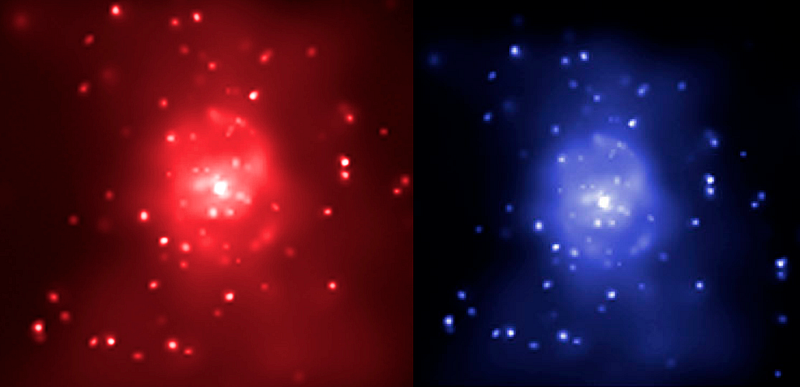
You can see, in the X-ray, above, that this galaxy looks anything but spherical, and that’s evidenced by the faint outer edges that show a temperature gradient between the leading edge (upper left) and the trailing edge (lower right) of the galaxy as it speeds through the dense intergalactic medium of the Virgo Cluster.
But what you’ll also notice is this strange dual-lobed structure coming from the galaxy’s center, something that isn’t an optical feature in the visible portion of the spectrum.
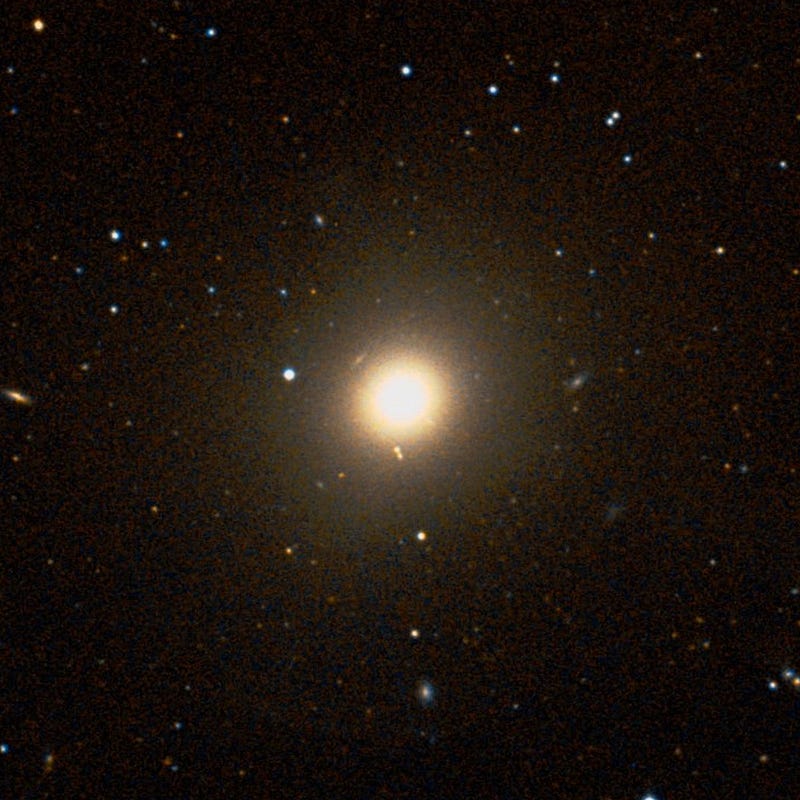
These bubble-like features in the X-ray are actually cavities of hot gas caused by a spinning supermassive black hole. For a long time, these features were unknown, but when Chandra uncovered them it was quickly realized what the cause was, and they were discovered to exist in a very large fraction of giant ellipticals!
But, as you may have guessed, these nearby giant ellipticals are only so prominent to us because they’re so massive and full of stars. They’re not, however, the most numerous type of galaxy. A quick glance at an image from the Sloan Digital Sky Survey shows a large number of “other” Virgo Cluster members that are simply washed out by the presence of Messier 89!
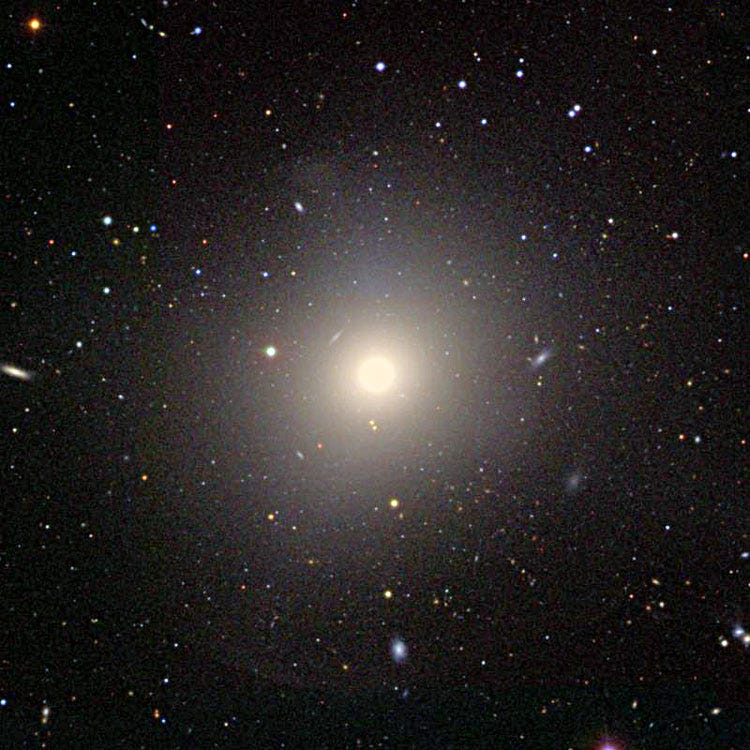
This galaxy, though, despite its nearly spherical appearance, is actually enveloped by a large, non-symmetrical structure, something discovered by David Malin back in 1979. Have a look at this image!
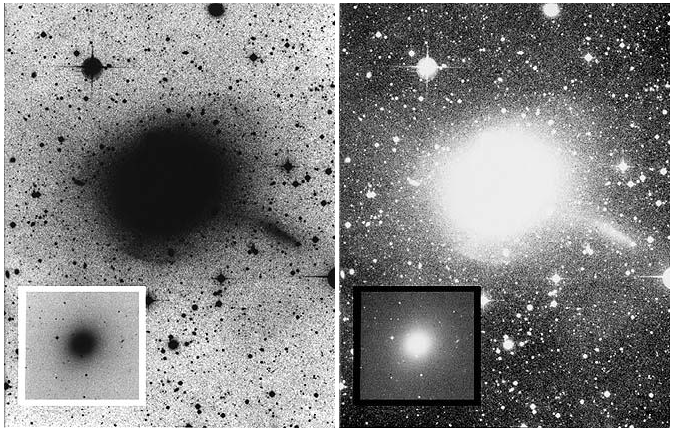
What you’re seeing is not just a large envelope of stars and globular clusters, but also a tiny, much lower-mass galaxy in the process of being devoured by its larger neighbor, M89!
As always (when it’s available), the most spectacular shot of this galaxy comes from the Hubble Space Telescope.
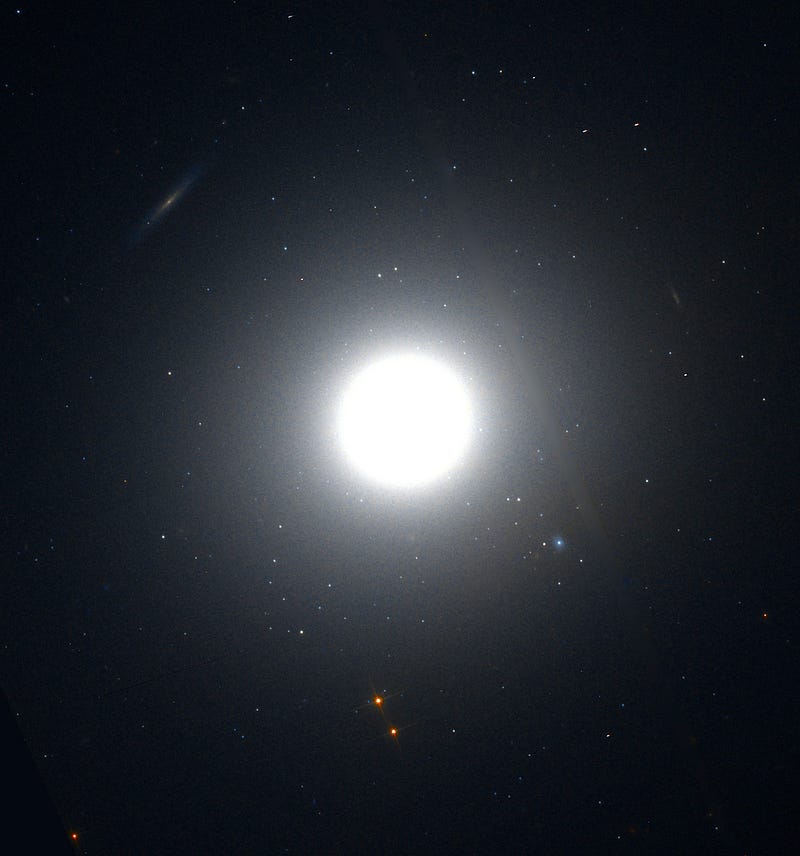
The occasional foreground star is visible here, but what I really want to draw your attention to — something that’s available if you look at this picture at its full resolution — is the sheer richness of what lies behind this galaxy.
Take a look for yourself at this slice just to one side of the galactic center, at not only the large but the many smaller “smudges” that exist around this galaxy; everything that’s visible as more than a single point of light is a galaxy in its own right!
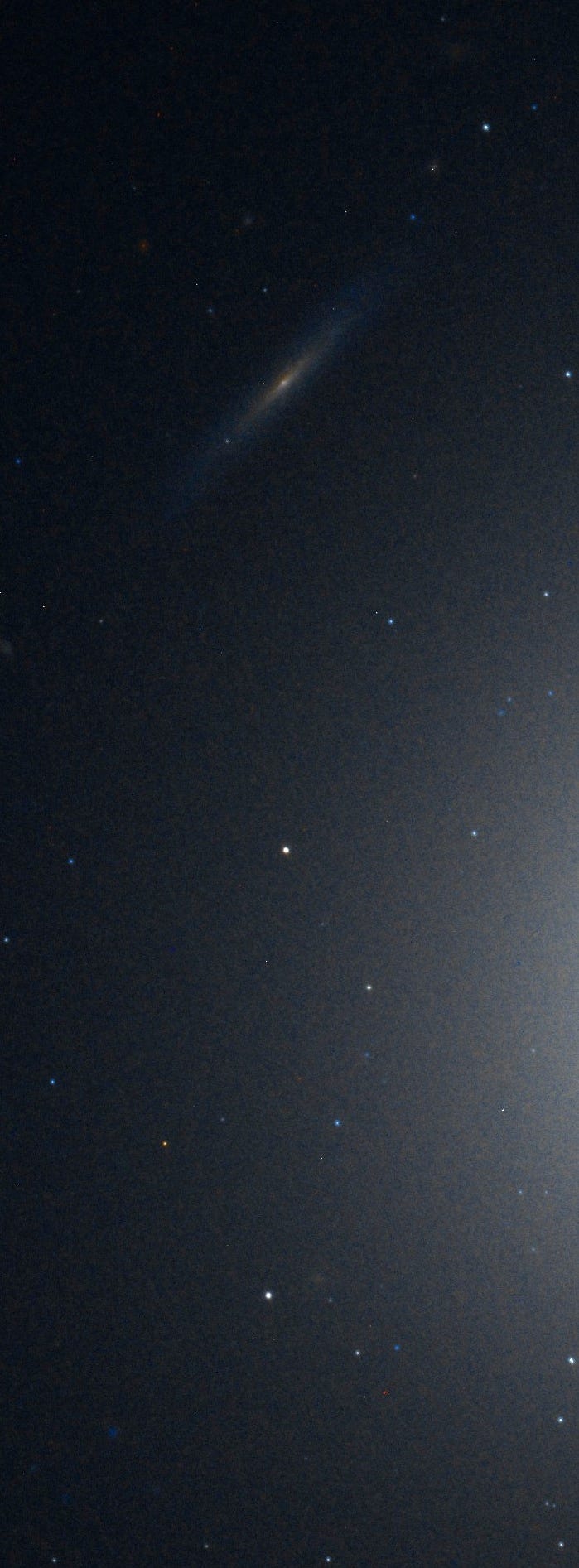
And with that fun little glimpse into this corner of the Universe, we arrive at the end of another Messier Monday! Including today’s object, here are the ones we’ve profiled so far:
- M1, The Crab Nebula: October 22, 2012
- M2, Messier’s First Globular Cluster: June 17, 2013
- M3, Messier’s First Original Discovery: February 17, 2014
- M4, A Cinco de Mayo Special: May 5, 2014
- M5, A Hyper-Smooth Globular Cluster: May 20, 2013
- M7, The Most Southerly Messier Object: July 8, 2013
- M8, The Lagoon Nebula: November 5, 2012
- M9, A Globular from the Galactic Center: July 7, 2014
- M10, A Perfect Ten on the Celestial Equator: May 12, 2014
- M11, The Wild Duck Cluster: September 9, 2013
- M12, The Top-Heavy Gumball Globular: August 26, 2013
- M13, The Great Globular Cluster in Hercules: December 31, 2012
- M14, The Overlooked Globular: June 9, 2014
- M15, An Ancient Globular Cluster: November 12, 2012
- M18, A Well-Hidden, Young Star Cluster: August 5, 2013
- M20, The Youngest Star-Forming Region, The Trifid Nebula: May 6, 2013
- M21, A Baby Open Cluster in the Galactic Plane: June 24, 2013
- M23, A Cluster That Stands Out From The Galaxy: July 14, 2014
- M25, A Dusty Open Cluster for Everyone: April 8, 2013
- M27, The Dumbbell Nebula: June 23, 2014
- M29, A Young Open Cluster in the Summer Triangle: June 3, 2013
- M30, A Straggling Globular Cluster: November 26, 2012
- M31, Andromeda, the Object that Opened Up the Universe: September 2, 2013
- M32, The Smallest Messier Galaxy: November 4, 2013
- M33, The Triangulum Galaxy: February 25, 2013
- M34, A Bright, Close Delight of the Winter Skies: October 14, 2013
- M36, A High-Flying Cluster in the Winter Skies: November 18, 2013
- M37, A Rich Open Star Cluster: December 3, 2012
- M38, A Real-Life Pi-in-the-Sky Cluster: April 29, 2013
- M39, The Closest Messier Original: November 11, 2013
- M40, Messier’s Greatest Mistake: April 1, 2013
- M41, The Dog Star’s Secret Neighbor: January 7, 2013
- M42, The Great Orion Nebula: February 3, 2014
- M44, The Beehive Cluster / Praesepe: December 24, 2012
- M45, The Pleiades: October 29, 2012
- M46, The ‘Little Sister’ Cluster: December 23, 2013
- M47, A Big, Blue, Bright Baby Cluster: December 16, 2013
- M48, A Lost-and-Found Star Cluster: February 11, 2013
- M49, Virgo’s Brightest Galaxy: March 3, 2014
- M50, Brilliant Stars for a Winter’s Night: December 2, 2013
- M51, The Whirlpool Galaxy: April 15th, 2013
- M52, A Star Cluster on the Bubble: March 4, 2013
- M53, The Most Northern Galactic Globular: February 18, 2013
- M56, The Methuselah of Messier Objects: August 12, 2013
- M57, The Ring Nebula: July 1, 2013
- M58, The Farthest Messier Object (for now): April 7, 2014
- M59, An Elliptical Rotating Wrongly: April 28, 2014
- M60, The Gateway Galaxy to Virgo: February 4, 2013
- M61, A Star-Forming Spiral: April 14, 2014
- M63, The Sunflower Galaxy: January 6, 2014
- M64, The Black Eye Galaxy: February 24, 2014
- M65, The First Messier Supernova of 2013: March 25, 2013
- M66, The King of the Leo Triplet: January 27, 2014
- M67, Messier’s Oldest Open Cluster: January 14, 2013
- M68, The Wrong-Way Globular Cluster: March 17, 2014
- M71, A Very Unusual Globular Cluster: July 15, 2013
- M72, A Diffuse, Distant Globular at the End-of-the-Marathon: March 18, 2013
- M73, A Four-Star Controversy Resolved: October 21, 2013
- M74, The Phantom Galaxy at the Beginning-of-the-Marathon: March 11, 2013
- M75, The Most Concentrated Messier Globular: September 23, 2013
- M77, A Secretly Active Spiral Galaxy: October 7, 2013
- M78, A Reflection Nebula: December 10, 2012
- M79, A Cluster Beyond Our Galaxy: November 25, 2013
- M80, A Southern Sky Surprise: June 30, 2014
- M81, Bode’s Galaxy: November 19, 2012
- M82, The Cigar Galaxy: May 13, 2013
- M83, The Southern Pinwheel Galaxy, January 21, 2013
- M84, The Galaxy at the Head-of-the-Chain, May 26, 2014
- M85, The Most Northern Member of the Virgo Cluster, February 10, 2014
- M86, The Most Blueshifted Messier Object, June 10, 2013
- M87, The Biggest One of them All, March 31, 2014
- M88, A Perfectly Calm Spiral in a Gravitational Storm, March 24, 2014
- M89, The Most Perfect Elliptical, July 21, 2014
- M90, The Better-You-Look, The Better-It-Gets Galaxy, May 19, 2014
- M91, A Spectacular Solstice Spiral, June 16, 2014
- M92, The Second Greatest Globular in Hercules, April 22, 2013
- M93, Messier’s Last Original Open Cluster, January 13, 2014
- M94, A double-ringed mystery galaxy, August 19, 2013
- M95, A Barred Spiral Eye Gazing At Us, January 20, 2014
- M96, A Galactic Highlight to Ring in the New Year, December 30, 2013
- M97, The Owl Nebula, January 28, 2013
- M98, A Spiral Sliver Headed Our Way, March 10, 2014
- M99, The Great Pinwheel of Virgo, July 29, 2013
- M101, The Pinwheel Galaxy, October 28, 2013
- M102, A Great Galactic Controversy: December 17, 2012
- M103, The Last ‘Original’ Object: September 16, 2013
- M104, The Sombrero Galaxy: May 27, 2013
- M105, A Most Unusual Elliptical: April 21, 2014
- M106, A Spiral with an Active Black Hole: December 9, 2013
- M107, The Globular that Almost Didn’t Make it: June 2, 2014
- M108, A Galactic Sliver in the Big Dipper: July 22, 2013
- M109, The Farthest Messier Spiral: September 30, 2013
Next week will bring us the final Virgo Cluster galaxy in Messier’s catalogue, so make sure you don’t miss it! (And if you missed our Comments of the Week, check those out, too.) Thanks for joining me, and I’ll see you back here soon for more wonders of the Universe!
Leave your comments at the Starts With A Bang forum on Scienceblogs!





